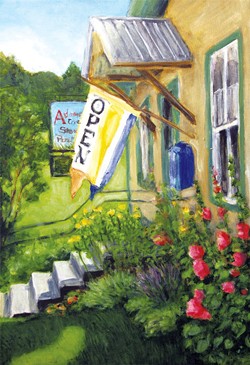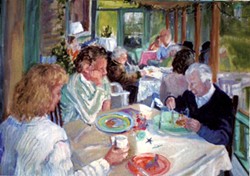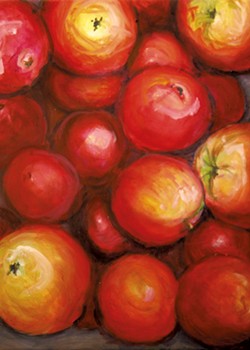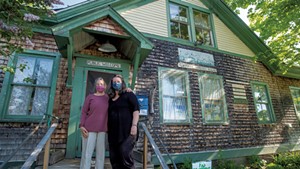
- Janet Macleod
Five dirt roads converge in Adamant, which is neither town nor incorporated village but a cluster of houses at the head of a pond whiskered with cattails. Years ago, the hamlet went by Sodom (the pond still bears that name), and though it has its own zip code — 05640 — Adamant is in Calais, part and parcel.
Here, tiny Adamant Co-op serves coffee and scones, ice cream and candies, much as it has since 1935. The store is often described as Vermont's (and maybe the nation's) oldest co-op in continuous operation, but no one will say so with 100 percent surety. "An academic paper from Cornell said it was the oldest," says Janet MacLeod, standing in the store's upstairs kitchen last week. "And we can't find anyone to refute that."
MacLeod has lived in the area for most of her 70 years. Her father-in-law was a co-op founder; her grandparents were original members.
"Janet grew up here," says Larry Floersch, who moved to Adamant in 1984.
"Actually, not here," MacLeod says. As a youth, she lived just down the road in East Montpelier, where she still is today. "But we call ourselves from Adamant," she says. "I live in Adamant or near Adamant."
"I live in the suburbs of Adamant," Floersch says with a grin.
MacLeod and Floersch are two of a handful of volunteers who, along with six part-time staffers, run the co-op, handling day-to-day clerking, stocking, bookkeeping, cooking and other duties. They also tend the post office — a "CPU," or contract postal unit in government-speak — tucked into a corner of the store. About half of its 107 PO boxes are in regular use. The store also serves as a mail drop, where the postmaster receives and sorts mail for the local route.
Without the signage advertising "baked goods," "fresh eggs," "produce" and "lunch," the cedar-shingled building — once a dormitory for quarry workers — could pass for a private home. Up a few steps, the front door opens to a single room, all battered wood floors and shelving stuffed with dry goods, cans and sundries.

- Janet Macleod
Along the front wall, jars hold Swedish Fish, gummy bears and Tootsie Rolls; a nearby table is set with coffee pots and more jars filled with scones, muffins and cookies. At the center of the room, a woodstove radiates heat toward two chairs — inviting customers and workers to sit a while — and the register, a few feet away.
And so it has been, with variations on this theme since the co-op's original members co-opted the store from a local shopkeeper at the height of the Great Depression. Adamant is home to a couple of old churches and a music school, but the store is the sole amenity offering essential services in a place that's close to everything — less than eight miles from downtown Montpelier — but convenient to nothing.
It's one of those small towns where the village store is the beating heart of the village: a rushed stop for morning coffee or a bottle of wine on the way home; host to summer cookouts or brunches; the place to grab lunch while posting a letter or stack of bills. The store tells of an everyday history, punctuated by food.
Fitting, then, that co-op members would compile house recipes — for sweet breads and muffins, empanadas, soups, and pot pies, along with their favored party dishes — into a cookbook to celebrate the store's 80 years in business.
Assembled over the course of a year, the Adamant Co-op Cookbook offers quintessential Vermont food, the kind cooked at home with common ingredients such as eggs and flour and garden produce, prepared with care and thought but little fuss. Many recipes are formatted to feed a crowd, a sweet reminder that one's cooking often tastes best when it is shared among friends.
Floersch — a columnist at Montpelier's weekly newspaper the Bridge and a former editor of medical journals — stepped up to edit the book. He solicited co-op members' poetry, essays and vignettes. They set scenes of winter cats lying "so close to the woodstove it's a wonder they don't combust"; describe neighborly relations ("no matter the opinions or politics, we all feel obliged to help each other out"); or detail summer's evanescent edibles: "the moment of chanterelles is now and may not come again."
The anecdotes ring familiar to anyone who's spent much time in the hills north of the capital, and they imbue the recipes with a sense of place.

- Janet Macleod
MacLeod — a Rhode Island School of Design-trained artist whose studio is above the store — painted soups and produce, quiches and cakes, creating more than 100 illustrations to color the book. While members tested the recipes in their home kitchens, she would perch at the end of a counter, watching and sketching, nibbling and chatting, grateful for the excuse to visit, she recalls.
As the days shorten and truck toward year's end, we've excerpted recipes from the book (along with their introductions) to match the season. All geared toward group cooking or dining, they could provide a day's labor for one — or a ready opportunity to convene, cook and commune.
Apple Butter

- Janet Macleod
Richard Czaplinski's apple butter recipe (below) comes from the book Putting Food By by Ruth Hertzberg, Beatrice Vaughan and Janet Greene, but he modified it a bit. The secret is boiling the apples in apple cider and using apples that seem to capture that tangy apple flavor.
Cook about 5 quarts of apples, unpeeled and quartered with stems and blossom ends (and cores if you like) taken out, over low heat in several cups of apple cider. Process in a food mill.
To the processed applesauce, add spices (about a tablespoon of cinnamon, about a half teaspoon of ground cloves, about a half teaspoon of ground allspice). You'll need to experiment here to get the taste you like. Add some sugar to bring out flavor, but avoid making it too sweet (use much less than recipes usually call for). You'll need to experiment here, too. Simmer over low heat for two hours or more. The butter will get thick and take on a darker color. It will splatter as bubbles pop, so be careful. You'll need to stir the butter frequently so the bottom does not scorch.
Put butter in jars (leave plenty of room, as the butter will expand some in the bath) and process in a water bath. Be sure to leave the lids loose but closed. Bring bath to a boil, and slow boil for about 10 minutes. Remove jars, tighten the lids, store and enjoy.
Butternut Squash Soup With Ginger

- Janet Macleod
Butternut squash has a rich, nutty taste and is a "must-have" ingredient in the autumn and winter kitchen. This hearty and soul-warming soup is not only a great winter favorite but is also very popular during the holiday season. Imagine coming home, after a long snowshoe hike in the woods, to the mouthwatering aromas of squash and ginger.
- 1 pound butternut squash
- 1 onion
- 1 potato
- 1 walnut-size piece of ginger
- 1 can of coconut milk (400 grams/14 ounces)
- 2 teaspoons red curry paste (or 2 tablespoons curry powder)
- 14 ounces vegetable broth
- Salt
- Peel the squash and cut into small pieces. Finely cut the onion. Peel the potato and cut into small pieces. Peel and cut the ginger.
- Open the coconut milk and put the thick cream into a pot; heat slowly. Add onion, ginger and curry; stir and let cook for about five minutes. Add squash; cook for about two minutes. Add remaining coconut milk, broth, potato and salt. Cook until vegetables are soft (about 20 minutes). Purée and season to taste.
- Guests coming over? Garnish soup with roasted pumpkin seeds or a few dribbles of pumpkin-seed oil. Wine pairing: Enjoy this soup with a good dry Riesling.
Red Flannel Hash
As made for the harvest supper at the Adamant United Methodist Church.
We got this recipe from Kathi Doner and have modified it somewhat. It should feed at least 20 people — in any event, it fills a large roasting pan. You can use either ham or corned beef. We used ham for the harvest supper the last few years.
- 4 pounds corned beef or ham
- 6 quarts potatoes, peeled and quartered
- 2 pounds onions, peeled and quartered
- 4 pounds carrots, cut into 3-inch pieces
- 1 to 2 heads of cabbage
- 2 turnips, peeled and quartered (optional)
- Beets
- Bake or boil the beef or ham for about 30 minutes (until tender). Reserve the broth and cook potatoes, onions, carrots, cabbage and turnips until tender. Reserve liquid.
- Boil beets separately.
- Grind everything together. Add reserved liquid if too dry. No salt or pepper should be necessary.
- If you make this dish one day ahead of serving it, the flavors will blend together nicely. Just remember that it will take about two hours to warm it properly. Warm it to 250 to 300ºF so the beets won't bleed.










Comments
Comments are closed.
From 2014-2020, Seven Days allowed readers to comment on all stories posted on our website. While we've appreciated the suggestions and insights, right now Seven Days is prioritizing our core mission — producing high-quality, responsible local journalism — over moderating online debates between readers.
To criticize, correct or praise our reporting, please send us a letter to the editor or send us a tip. We’ll check it out and report the results.
Online comments may return when we have better tech tools for managing them. Thanks for reading.